Research on a Plan of Free Cooling Operation Control for the Efficiency Improvement of a Water-Side Economizer
Abstract
1. Introduction
1.1. Background and Literature Review
1.2. Motivation and Goals
1.3. Research Scope
2. Methodology
2.1. Free Cooling Operation Conditions of a WSE System
2.2. Free Cooling Period Extension Plan
2.2.1. Plan 1: Increase in the CRAH Fan Air Flow
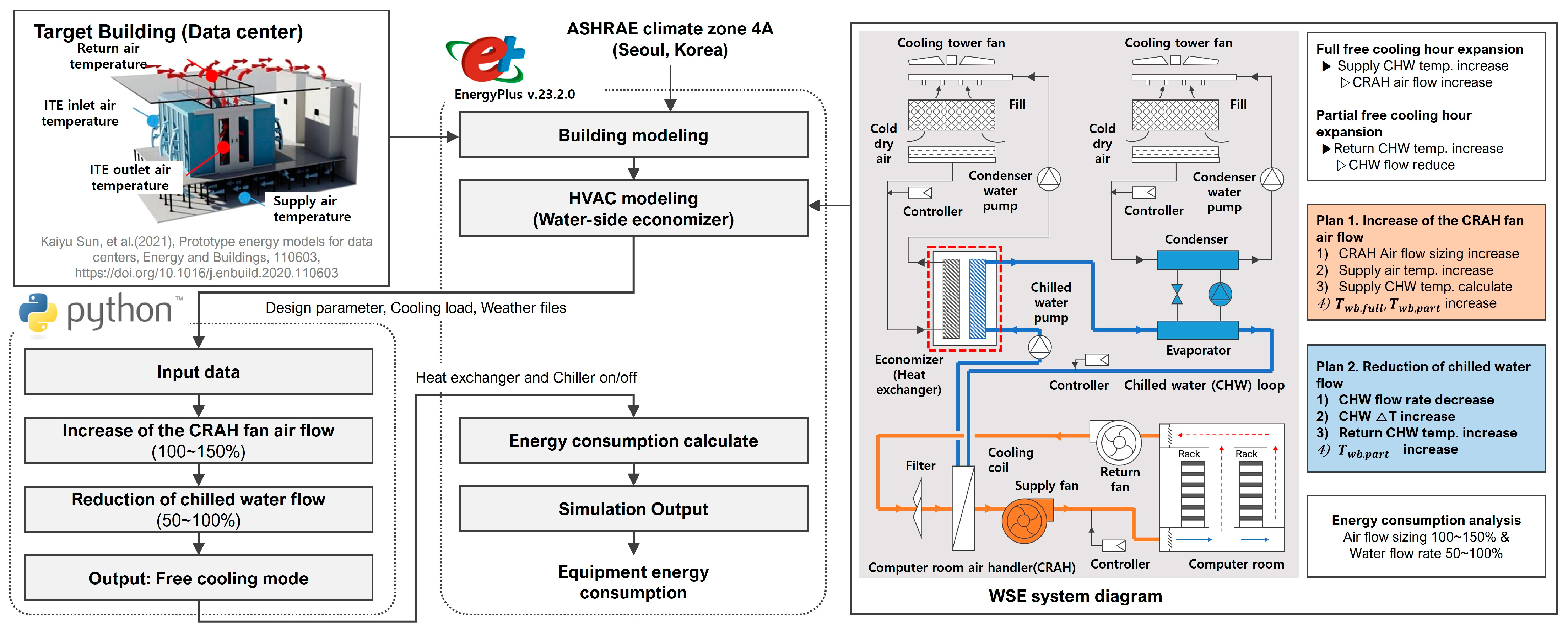
2.2.2. Plan 2: Reduction in the Chilled Water Flow
3. Simulation Modeling
3.1. HVAC Physics-Based Model
3.1.1. Cooling Tower
3.1.2. Water-Cooled Chiller
3.1.3. Heat Exchanger (Economizer)
3.1.4. CRAH Fan
3.1.5. Pumps
3.2. HVAC System Summary (Baseline)
4. Simulation Results and Discussion
4.1. Energy Usage and Free Cooling Operation Time
4.2. Detailed Analysis of the Operation Data
4.2.1. Increase in the CRAH Fan Air Flow
4.2.2. Reduction in the Chilled Water Flow
5. Conclusions and Future Work
Author Contributions
Funding
Data Availability Statement
Acknowledgments
Conflicts of Interest
Nomenclature
| Model Variables | Physics Model Equations | ||
| Upper limit of the wet bulb temperature during full free cooling operation (°C) | Temperature of cooling water (°C) | ||
| Upper limit of wet bulb temperature during partial free cooling operation (°C) | Temperature of outdoor air web bulb (°C) | ||
| Chilled water supply temperature (°C) | Cooling water return temperature (°C) | ||
| Chilled water return temperature (°C) | Cooling water supply temperature (°C) | ||
| Cooling tower approach temperature (°C) | Treatment calorie of the equipment (kW) | ||
| Heat exchanger approach temperature (°C) | Load of rated condition (kW) | ||
| Supply air temperature (°C) | Flow of cooling water (kg/s) | ||
| Return air temperature (°C) | Air flow of the cooling tower fan (kg/s) | ||
| Supply-side inlet temperature of the heat exchanger (°C) | Air flow of designed condition (kg/s) | ||
| Demand-side inlet temperature of the heat exchanger (°C) | Air enthalpy of the cooling tower (J/kg) | ||
| Temperature difference of water (K) | Specific heat of cooling water (kJ/kg·K) | ||
| Treatment calorie of coil (kW) | Air flow of the CRAH fan (kg/s) | ||
| Treatment calorie of the heat exchanger (kW) | Operation ratio of the CRAH fan | ||
| Airflow of the air (kg/s) | Efficiency of the CRAH fan | ||
| Supply-side flow of heat exchanger (kg/s) | Density of the air (kg/m3) | ||
| Demand-side flow of heat exchanger (kg/s) | Electrical power of the chiller (kW) | ||
| Specific heat of the air (kJ/kg·K) | Performance coefficient of rated condition | ||
| Specific heat of water (kJ/kg·K) | Cooling capacity function of the temperature curve | ||
| Specific heat of water at the supply side of the heat exchanger (kJ/kg·K) | Energy input to cooling output ratio function of the temperature curve | ||
| Specific heat of water at the demand side of the heat exchanger (kJ/kg·K) | Energy input to cooling output ratio function of the part load ratio curve | ||
| Efficiency of the crosstype heat exchanger | Part load ratio | ||
| Heat capacity ratio | |||
| Efficiency of the heat exchanger | |||
| Number of transfer units | |||
References
- Ebrahimi, K.; Jones, G.F.; Fleischer, A.S. A Review of Data Center Cooling Technology, Operating Conditions and the Corresponding Low-Grade Waste Heat Recovery Opportunities. Renew. Sustain. Energy Rev. 2014, 31, 622–638. [Google Scholar] [CrossRef]
- Hassan, S.F.; Ali, M.; Perwez, U.; Sajid, A. Free Cooling Investigation of RCMS Data Center. Energy Procedia 2015, 75, 1249–1254. [Google Scholar] [CrossRef]
- Zhang, H.; Shao, S.; Xu, H.; Zou, H.; Tian, C. Free Cooling of Data Centers: A Review. Renew. Sustain. Energy Rev. 2014, 35, 171–182. [Google Scholar] [CrossRef]
- Daraghmeh, H.M.; Wang, C.C. A Review of Current Status of Free Cooling in Datacenters. Appl. Therm. Eng. 2017, 114, 1224–1239. [Google Scholar] [CrossRef]
- Dayarathna, M.; Wen, Y.; Fan, R. Data Center Energy Consumption Modeling: A Survey. IEEE Commun. Surv. Tutor. 2016, 18, 732–794. [Google Scholar] [CrossRef]
- Zou, S.; Zhang, Q.; Yue, C. Comparative Study on Different Energy-Saving Plans Using Water-Side Economizer to Retrofit the Computer Room Air Conditioning System. J. Build. Eng. 2023, 69, 106278. [Google Scholar] [CrossRef]
- Deymi-Dashtebayaz, M.; Namanlo, S.V. Potentiometric and Economic Analysis of Using Air and Water-Side Economizers for Data Center Cooling Based on Various Weather Conditions. Int. J. Refrig. 2019, 99, 213–225. [Google Scholar] [CrossRef]
- Kim, Y.-J.; Ha, J.-W.; Park, K.-S.; Song, Y.-H. A Study on the Energy Reduction Measures of Data Centers through Chilled Water Temperature Control and Water-Side Economizer. Energies 2021, 14, 3575. [Google Scholar] [CrossRef]
- Li, J.; Li, Z. Model-Based Optimization of Free Cooling Switchover Temperature and Cooling Tower Approach Temperature for Data Center Cooling System with Water-Side Economizer. Energy Build. 2020, 227, 110407. [Google Scholar] [CrossRef]
- Waterside Economizer Control in ASHRAE Research Project RP-1711. Available online: https://www.proquest.com/openview/6da882770f4132453342c9f41dd132d3/1?pq-origsite=gscholar&cbl=34619 (accessed on 20 July 2023).
- Beaty, D.L.; Quirk, D.; Frank, A.; Morrison, T. Column Data Centers Part 1: Tower Sizing Designing Data Center Water-Side Economizers for Cold Climates. ASHRAE J. 2018, 60, 74–79. [Google Scholar]
- Fan, C.; Hinkelman, K.; Fu, Y.; Zuo, W.; Huang, S.; Shi, C.; Mamaghani, N.; Faulkner, C.; Zhou, X. Open-Source Modelica Models for the Control Performance Simulation of Chiller Plants with Water-Side Economizer. Appl. Energy 2021, 299, 117337. [Google Scholar] [CrossRef]
- Yosuke, U.; Shisei, W.; Masahide, Y.; Wataru, F.; IEEE Staff. Study on Free Cooling Systems for Data Centers in Japan. In Proceedings of the INTELEC 2010-32nd International Telecommunications Energy Conference, Orlando, FL, USA, 6–10 June 2010; ISBN 9781424433841. [Google Scholar]
- Ma, K.; Liu, M.; Zhang, J. An Improved Particle Swarm Optimization Algorithm for the Optimization and Group Control of Water-Side Free Cooling Using Cooling Towers. Build. Env. 2020, 182, 107167. [Google Scholar] [CrossRef]
- Mi, R.; Bai, X.; Xu, X.; Ren, F. Energy Performance Evaluation in a Data Center with Water-Side Free Cooling. Energy Build. 2023, 295, 113278. [Google Scholar] [CrossRef]
- Data Center Chiller Plant, Simulation-Based Comparative Control Design Case Study. Available online: https://publications.ibpsa.org/conference/paper/?id=simbuild2022_C042 (accessed on 20 July 2023).
- Liu, J.; Su, L.; Dong, K.; Sun, Q.; Shao, Z.; Huang, G. Optimal Setting Parameters of Cooling System under Different Climate Zones for Data Center Energy Efficiency. Int. J. Energy Res. 2021, 45, 10086–10099. [Google Scholar] [CrossRef]
- Lee, K.P.; Cheng, T.A. A Simulation-Optimization Approach for Energy Efficiency of Chilled Water System. Energy Build. 2012, 54, 290–296. [Google Scholar] [CrossRef]
- Lin, P.; Avelar, V.; Bean, J. How Higher Chilled Water Temperature Can Improve Data Center Cooling System Efficiency. Int. J. Sci. Innov. Technol. 2018, 1, 88–101. [Google Scholar]
- Durand-Estebe, B.; Le Bot, C.; Mancos, J.N.; Arquis, E. Simulation of a Temperature Adaptive Control Strategy for an IWSE Economizer in a Data Center. Appl. Energy 2014, 134, 45–56. [Google Scholar] [CrossRef]
- Thomas, J.; Ed, J.W.; Jeff, P.; Amip, J.S.; Cullen, E.B. From chip to cooling tower data center modeling: Part 1 Influence of server inlet temperature and temperature rise across cabinet. In Proceedings of the Thermal and Thermomechanical Phenomena in Electronic Systems (ITherm), 2010 12th IEEE Intersociety Conference, Las Vegas, NV, USA, 2–5 June 2010; IEEE: Washington, DC, USA, 2010. ISBN 9781424453436. [Google Scholar]
- Fan, C.; Zhou, X. Model-Based Predictive Control Optimization of Chiller Plants with Water-Side Economizer System. Energy Build. 2023, 278, 1112633. [Google Scholar] [CrossRef]
- Silva-Llanca, L.; Ponce, C.; Bermúdez, E.; Martínez, D.; Díaz, A.J.; Aguirre, F. Improving Energy and Water Consumption of a Data Center via Air Free-Cooling Economization: The Effect Weather on Its Performance. Energy Convers. Manag. 2023, 292, 117344. [Google Scholar] [CrossRef]
- Energy Standard for Data Centers. 2019. Available online: https://www.ashrae.org/about/news/2016/data-center-standard-published-by-ashrae (accessed on 24 September 2023).
- Taylor, S.T. How to Design & Control Waterside Economizers. Ashrae J. 2014, 56, 30–36. [Google Scholar]
- EnergyPlusTM Engineering Reference; U.S. Department of Energy: Washington, DC, USA, 2021.
- Sun, K.; Luo, N.; Luo, X.; Hong, T. Prototype Energy Models for Data Centers. Energy Build. 2021, 231, 110603. [Google Scholar] [CrossRef]
- American Society of Heating Refrigerating and Air-Conditioning Engineers Inc. (ASHRAE). 2019 ASHRAE Handbook Heating Ventilating and Air-Conditioning Applications; American Society of Heating Refrigerating and Air-Conditioning Engineers Inc. (ASHRAE): Atlanta, GA, USA, 2019; ISBN 9781947192133. [Google Scholar]
- PHIKO (Passive House Institute Korea). Available online: https://climate.onebuilding.org/ (accessed on 20 September 2022).




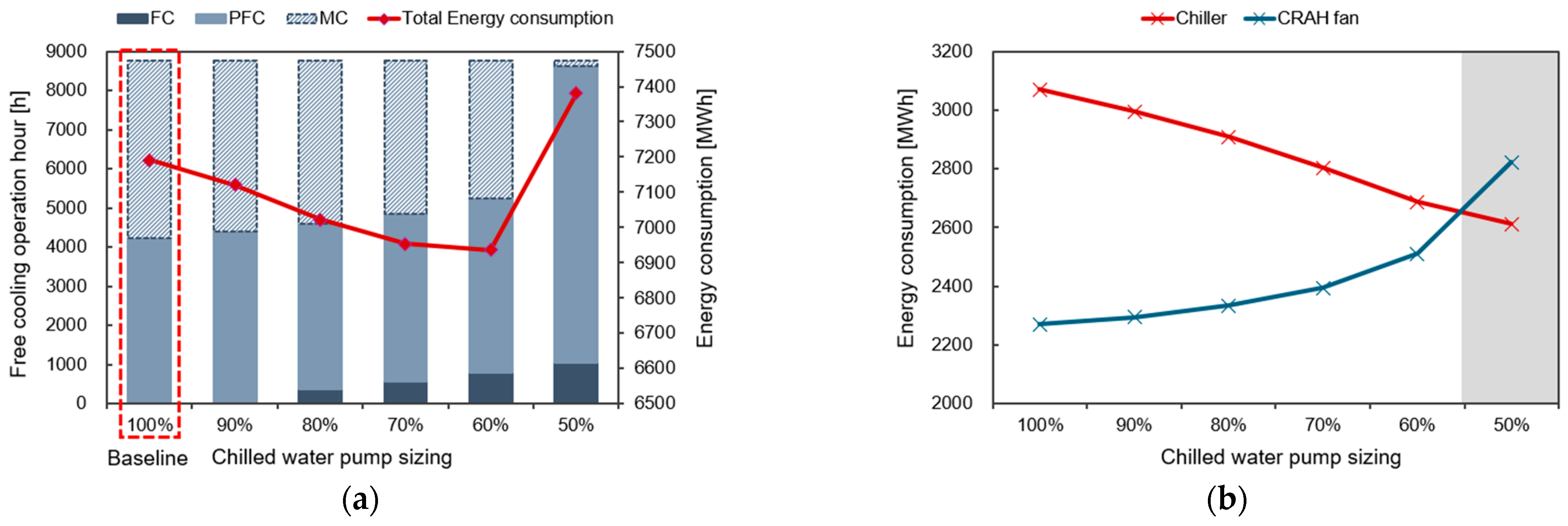
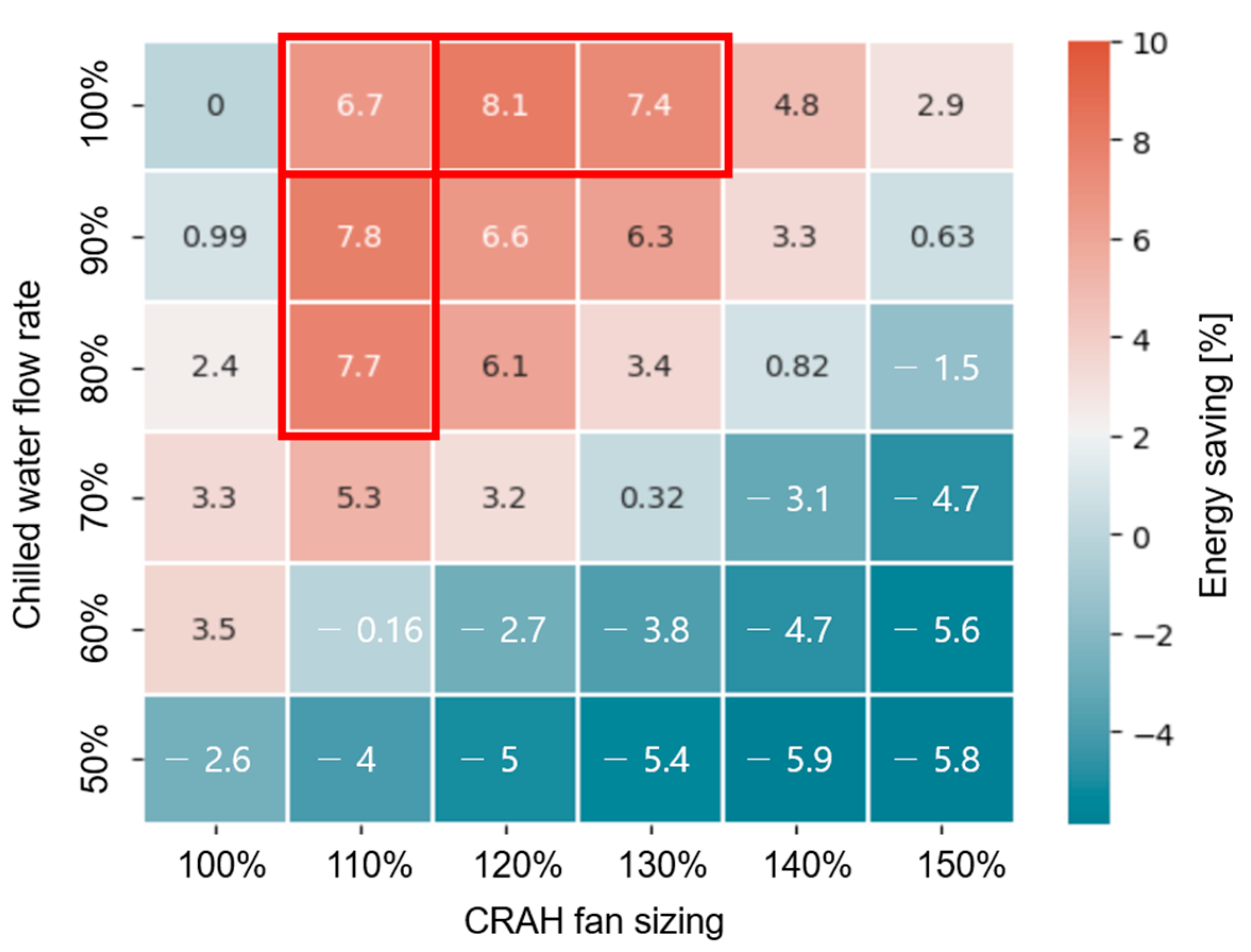

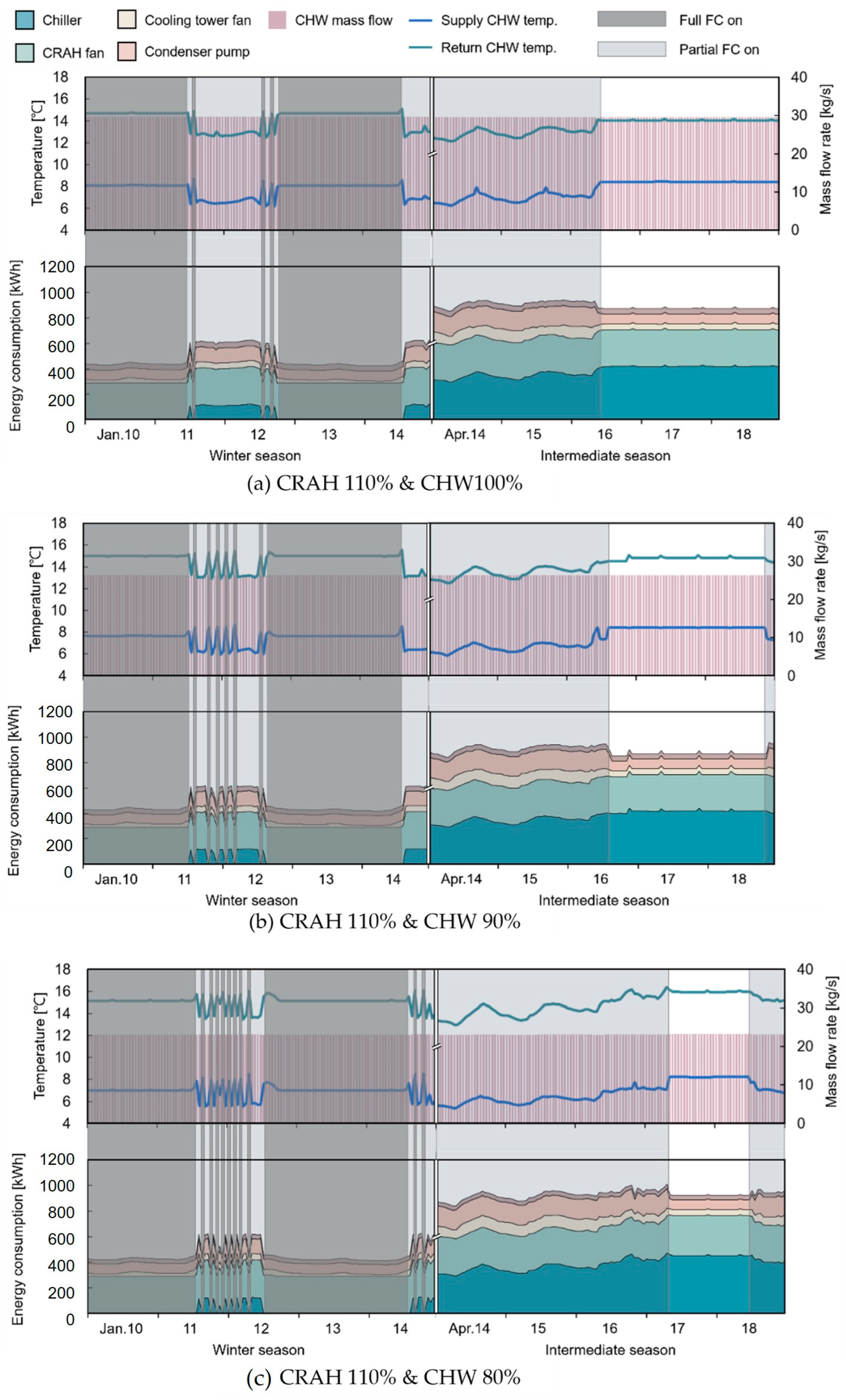
| Aspect | Content | |
|---|---|---|
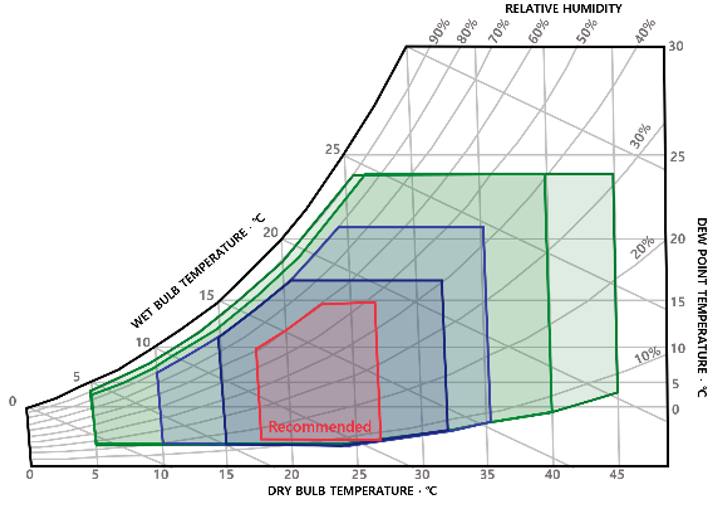 Environmental Classes for Datacom Equipment Classes (ASHRAE 2015a) | Use | Data center |
| Location/Climate zone | Seoul/4A | |
| Operation | 24 h/7 days | |
| Room dimension | 540 m2 (30 m × 18 m) | |
| Ceiling height/Access floor | 4 m/0.8 m | |
| IT load density | 5382 W/m2 | |
| Cooling set temperature | 26 °C |
| Equipment | Design Parameters | Value |
|---|---|---|
| Chiller [EA: 4] | Capacity | 847 kW |
| COP | 5.5 | |
| Chilled water flow rate | 0.0413 m3/s | |
| Condenser water flow rate | 0.0537 m3/s | |
| Chilled water outlet/inlet temperature | 7/12 | |
| Cooling tower [EA: 4] | Capacity | 1100 kW |
| Air flow rate | 44.75 m3/s | |
| Fan power | 12 kW | |
| Condenser water outlet/inlet temperature | 29/34 | |
| Pump [CHW pump EA: 4/ Condenser pump EA: 4] | Chilled water pump Power | 15 kW |
| Condenser water pump power | 19 kW | |
| CRAH fan [Supply fan EA: 4/ Return fan EA: 4] | Air flow rate | 56.82 m3/s |
| AHU air outlet/inlet temperature | 12.8/24 | |
| Fan power | 68.6 kW | |
| Heat Exchanger (WSE) [EA: 4] | Capacity | 847 kW |
| Efficiency | 0.9 |
Disclaimer/Publisher’s Note: The statements, opinions and data contained in all publications are solely those of the individual author(s) and contributor(s) and not of MDPI and/or the editor(s). MDPI and/or the editor(s) disclaim responsibility for any injury to people or property resulting from any ideas, methods, instructions or products referred to in the content. |
© 2024 by the authors. Licensee MDPI, Basel, Switzerland. This article is an open access article distributed under the terms and conditions of the Creative Commons Attribution (CC BY) license (https://creativecommons.org/licenses/by/4.0/).
Share and Cite
Kim, Y.-J.; Kim, K.-H.; Ha, J.-W.; Song, Y.-H. Research on a Plan of Free Cooling Operation Control for the Efficiency Improvement of a Water-Side Economizer. Energies 2024, 17, 2804. https://doi.org/10.3390/en17122804
Kim Y-J, Kim K-H, Ha J-W, Song Y-H. Research on a Plan of Free Cooling Operation Control for the Efficiency Improvement of a Water-Side Economizer. Energies. 2024; 17(12):2804. https://doi.org/10.3390/en17122804
Chicago/Turabian StyleKim, Yu-Jin, Kwang-Hee Kim, Ju-Wan Ha, and Young-Hak Song. 2024. "Research on a Plan of Free Cooling Operation Control for the Efficiency Improvement of a Water-Side Economizer" Energies 17, no. 12: 2804. https://doi.org/10.3390/en17122804
APA StyleKim, Y.-J., Kim, K.-H., Ha, J.-W., & Song, Y.-H. (2024). Research on a Plan of Free Cooling Operation Control for the Efficiency Improvement of a Water-Side Economizer. Energies, 17(12), 2804. https://doi.org/10.3390/en17122804






